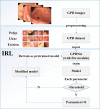Gastric precancerous diseases classification using CNN with a concise model
- PMID: 28950010
- PMCID: PMC5614663
- DOI: 10.1371/journal.pone.0185508
Gastric precancerous diseases classification using CNN with a concise model
Abstract
Gastric precancerous diseases (GPD) may deteriorate into early gastric cancer if misdiagnosed, so it is important to help doctors recognize GPD accurately and quickly. In this paper, we realize the classification of 3-class GPD, namely, polyp, erosion, and ulcer using convolutional neural networks (CNN) with a concise model called the Gastric Precancerous Disease Network (GPDNet). GPDNet introduces fire modules from SqueezeNet to reduce the model size and parameters about 10 times while improving speed for quick classification. To maintain classification accuracy with fewer parameters, we propose an innovative method called iterative reinforced learning (IRL). After training GPDNet from scratch, we apply IRL to fine-tune the parameters whose values are close to 0, and then we take the modified model as a pretrained model for the next training. The result shows that IRL can improve the accuracy about 9% after 6 iterations. The final classification accuracy of our GPDNet was 88.90%, which is promising for clinical GPD recognition.
Conflict of interest statement
Figures




Similar articles
-
Classification of precancerous lesions based on fusion of multiple hierarchical features.Comput Methods Programs Biomed. 2023 Feb;229:107301. doi: 10.1016/j.cmpb.2022.107301. Epub 2022 Dec 6. Comput Methods Programs Biomed. 2023. PMID: 36516661
-
Gastric dysplasia: the Padova international classification.Am J Surg Pathol. 2000 Feb;24(2):167-76. doi: 10.1097/00000478-200002000-00001. Am J Surg Pathol. 2000. PMID: 10680883 Review.
-
Gastric dysplasia: the Pavoda International Classification.Am J Surg Pathol. 2001 May;25(5):694. doi: 10.1097/00000478-200105000-00021. Am J Surg Pathol. 2001. PMID: 11342786 No abstract available.
-
Analysis of classification tradeoff in deep learning for gastric cancer detection.Annu Int Conf IEEE Eng Med Biol Soc. 2022 Jul;2022:2177-2180. doi: 10.1109/EMBC48229.2022.9871040. Annu Int Conf IEEE Eng Med Biol Soc. 2022. PMID: 36086270
-
[Gastric cancer].Rev Gastroenterol Peru. 1991;11(1):49-62. Rev Gastroenterol Peru. 1991. PMID: 1804329 Review. Spanish.
Cited by
-
The role of computer-assisted systems for upper-endoscopy quality monitoring and assessment of gastric lesions.Gastroenterol Rep (Oxf). 2021 Mar 12;9(3):185-204. doi: 10.1093/gastro/goab008. eCollection 2021 Jun. Gastroenterol Rep (Oxf). 2021. PMID: 34316369 Free PMC article. Review.
-
Prediction of Submucosal Invasion for Gastric Neoplasms in Endoscopic Images Using Deep-Learning.J Clin Med. 2020 Jun 15;9(6):1858. doi: 10.3390/jcm9061858. J Clin Med. 2020. PMID: 32549190 Free PMC article.
-
Deep learning with convolutional neural networks for identification of liver masses and hepatocellular carcinoma: A systematic review.World J Gastrointest Oncol. 2019 Dec 15;11(12):1218-1230. doi: 10.4251/wjgo.v11.i12.1218. World J Gastrointest Oncol. 2019. PMID: 31908726 Free PMC article.
-
Deep learning as a novel method for endoscopic diagnosis of chronic atrophic gastritis: a prospective nested case-control study.BMC Gastroenterol. 2022 Jul 25;22(1):352. doi: 10.1186/s12876-022-02427-2. BMC Gastroenterol. 2022. PMID: 35879649 Free PMC article.
-
Diagnosis to dissection: AI's role in early detection and surgical intervention for gastric cancer.J Robot Surg. 2024 Jun 20;18(1):259. doi: 10.1007/s11701-024-02005-6. J Robot Surg. 2024. PMID: 38900376 Review.
References
-
- Ajani JA, Bentrem DJ, Besh S, D’Amico TA, Das P, Denlinger C, et al. Gastric cancer, version 2.2013. Journal of the National Comprehensive Cancer Network. 2013;11(5):531–46. - PubMed
-
- Isobe Y, Nashimoto A, Akazawa K, Oda I, Hayashi K, Miyashiro I, et al. Gastric cancer treatment in Japan: 2008 annual report of the JGCA nationwide registry. Gastric Cancer. 2011;14(4):301–16. doi: 10.1007/s10120-011-0085-6 - DOI - PMC - PubMed
-
- Weck MN, Brenner H. Prevalence of chronic atrophic gastritis in different parts of the world. Cancer Epidemiology and Prevention Biomarkers. 2006;15(6):1083–94. - PubMed
-
- Liu B, Zhang D, Xu R, Xu J, Wang X, Chen Q, et al. Combining evolutionary information extracted from frequency profiles with sequence-based kernels for protein remote homology detection. Bioinformatics. 2014;30(4):472–9. doi: 10.1093/bioinformatics/btt709 - DOI - PMC - PubMed
MeSH terms
LinkOut - more resources
Full Text Sources
Other Literature Sources
Medical

